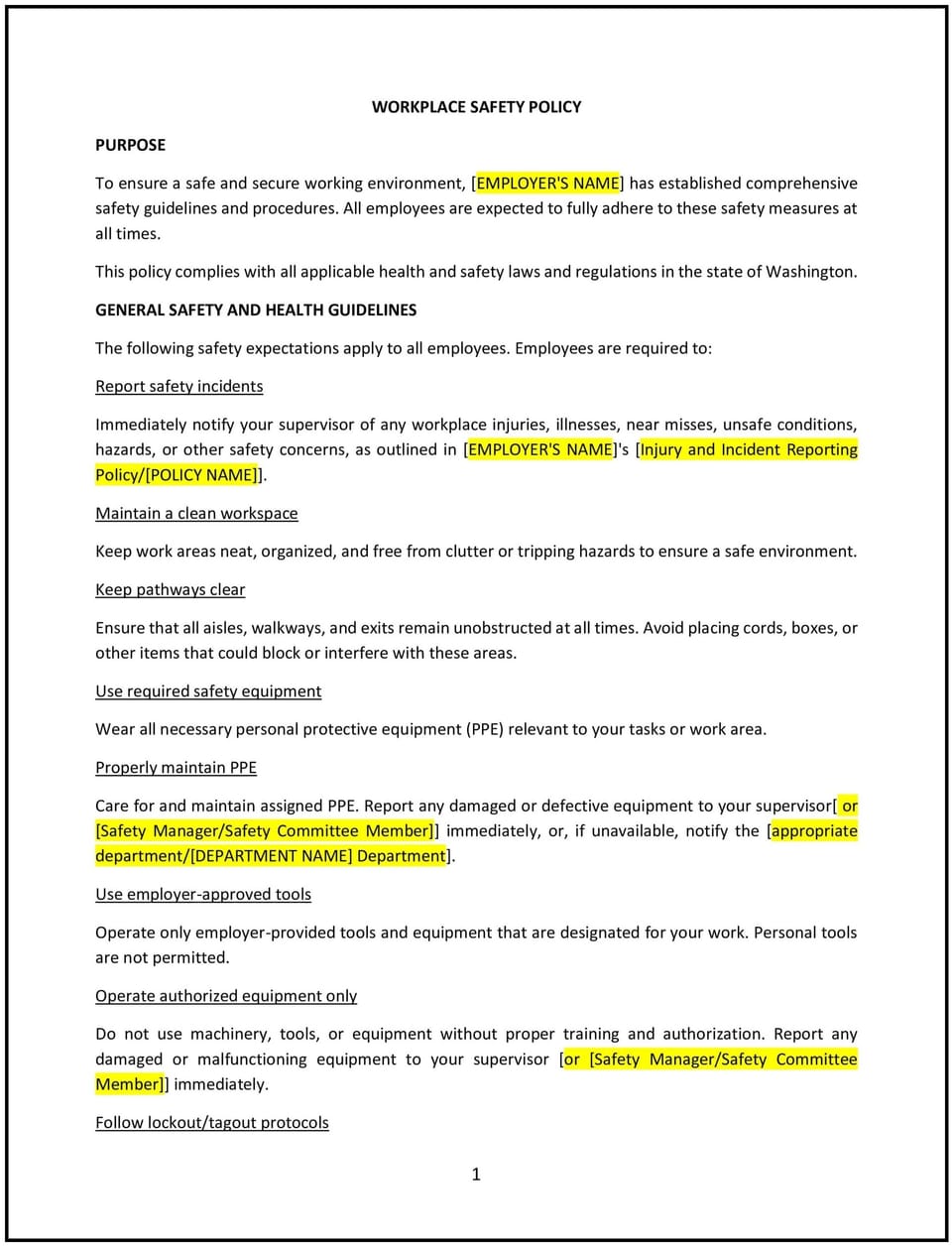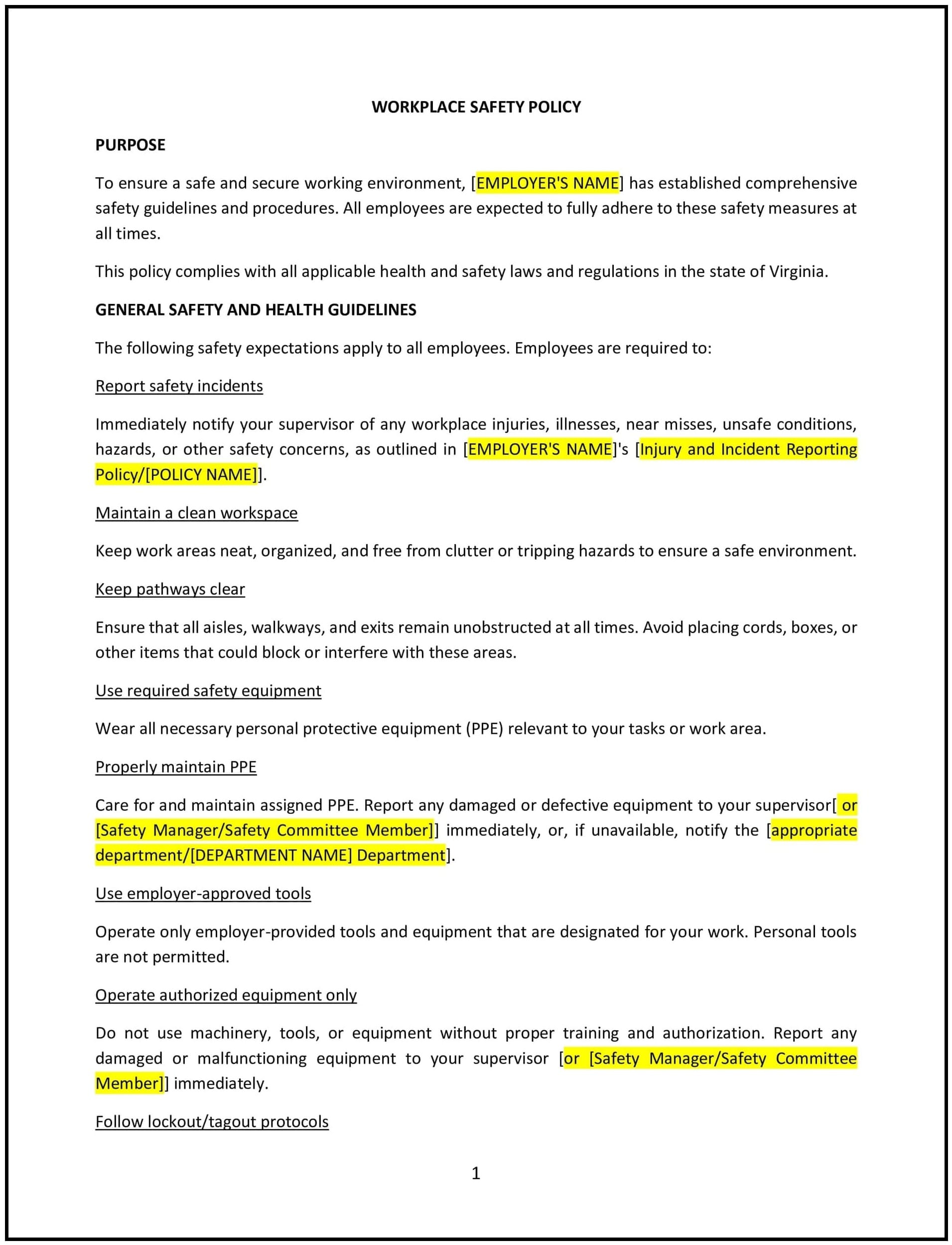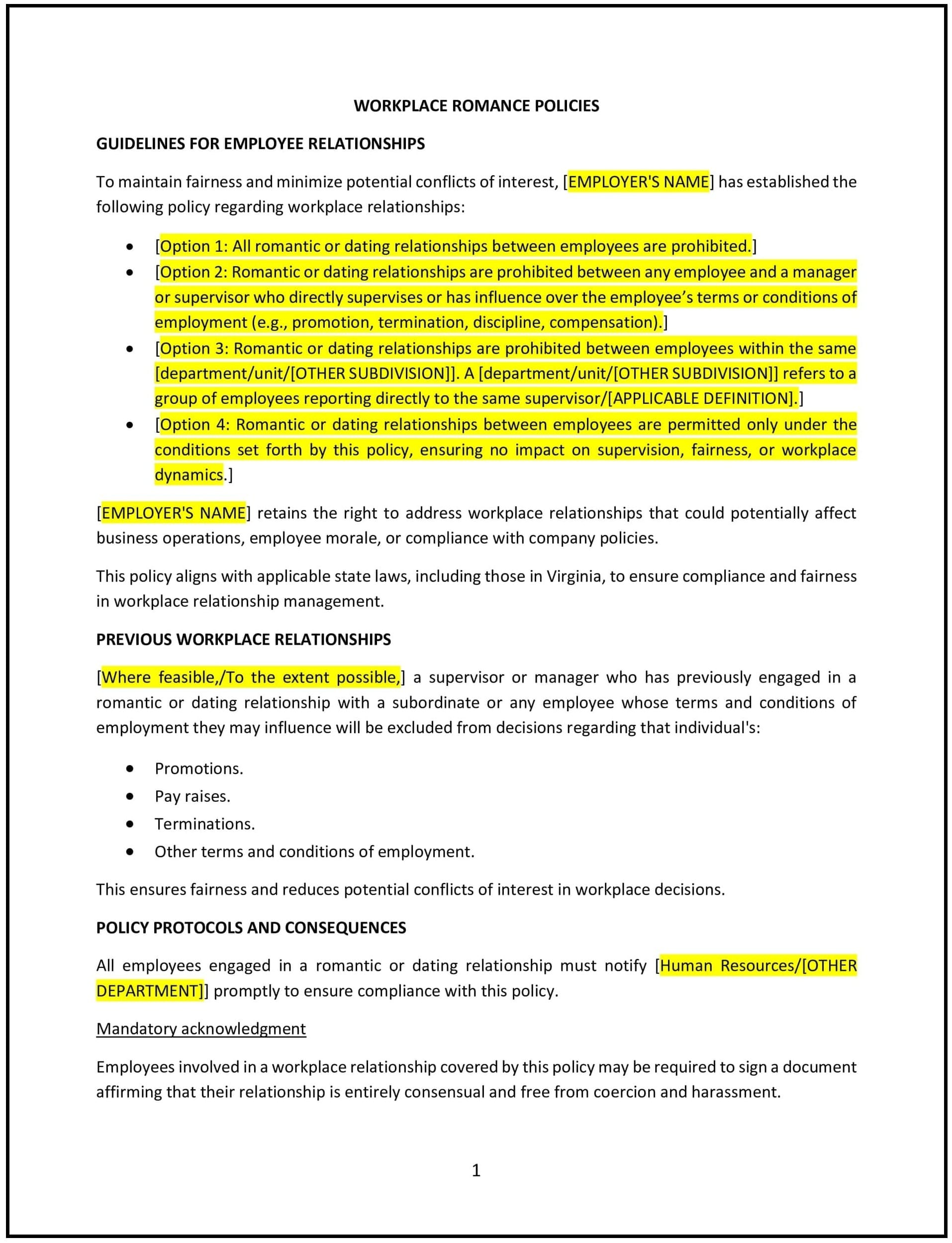Workplace safety policy (Washington): Free template

This workplace safety policy is designed to help Washington businesses establish and maintain a safe working environment for all employees. The policy outlines the company’s commitment to preventing accidents and injuries by implementing safety protocols, providing training, and encouraging safe practices. It defines roles and responsibilities for both employers and employees and sets out procedures for reporting hazards and handling safety concerns.
By adopting this policy, businesses can promote employee well-being, reduce the risk of workplace injuries, and create a culture of safety that aligns with Washington state laws and regulations.
How to use this workplace safety policy (Washington)
- Define safety responsibilities: The policy should outline the responsibilities of both employers and employees in maintaining a safe workplace. Employers are responsible for providing a safe environment, while employees must follow safety procedures and report hazards.
- Identify workplace hazards: The policy should include a process for identifying and assessing potential hazards in the workplace. It should specify how hazards should be reported, including any necessary documentation, and the steps to address these hazards.
- Provide safety training: The policy should require regular safety training for all employees. This includes educating employees about proper safety procedures, equipment usage, emergency protocols, and the reporting process for unsafe conditions.
- Set emergency procedures: The policy should outline the emergency procedures to be followed in the event of an accident, fire, medical emergency, or other safety-related incidents. It should detail evacuation plans, emergency contact information, and procedures for administering first aid.
- Address safety equipment and resources: The policy should specify the safety equipment and resources provided by the company, such as protective gear, fire extinguishers, first aid kits, and safety signage. It should also set guidelines for maintaining and inspecting safety equipment.
- Promote employee involvement: The policy should encourage employees to participate in safety meetings, hazard assessments, and other safety-related activities. Engaging employees in safety initiatives helps create a culture of safety throughout the organization.
- Ensure compliance with Washington state laws: The policy should ensure compliance with Washington state laws, including the Washington Industrial Safety and Health Act (WISHA) and other relevant state and federal regulations. It should also align with the Occupational Safety and Health Administration (OSHA) standards.
- Review and update regularly: Periodically review and update the policy to ensure it remains compliant with Washington state laws, federal regulations, and any changes in company operations. Regular updates will help ensure the policy stays relevant and effective.
Benefits of using this workplace safety policy (Washington)
This policy offers several benefits for Washington businesses:
- Promotes employee health and safety: By defining clear safety protocols, the policy helps protect employees from accidents, injuries, and unsafe work conditions. This enhances employee well-being and reduces the risk of workplace-related health issues.
- Reduces legal risks: The policy helps businesses comply with Washington state laws and OSHA regulations, minimizing the risk of legal liabilities, fines, and lawsuits related to workplace safety violations.
- Improves employee morale: A workplace that prioritizes safety fosters a sense of security among employees, increasing job satisfaction, morale, and loyalty to the company.
- Increases productivity: A safe workplace reduces accidents and downtime, allowing employees to focus on their tasks without worrying about their safety. This leads to greater efficiency and productivity.
- Enhances company reputation: A company that demonstrates a commitment to safety is viewed positively by employees, potential hires, and the public. This improves the company’s reputation as a responsible and reliable employer.
- Mitigates workplace disruptions: By addressing safety concerns and implementing preventative measures, the policy reduces the likelihood of safety-related incidents that could disrupt operations or harm employees.
Tips for using this workplace safety policy (Washington)
- Communicate the policy clearly: Ensure that all employees are aware of the workplace safety policy and understand their role in maintaining a safe work environment. Include the policy in the employee handbook, review it during onboarding, and provide periodic reminders.
- Provide regular safety training: Offer regular safety training to employees, particularly in high-risk industries. Ensure employees know how to use safety equipment and understand emergency procedures.
- Encourage a culture of safety: Foster a workplace culture where employees feel comfortable reporting hazards and safety concerns. Provide them with the necessary resources to do so, such as a designated safety officer or reporting hotline.
- Monitor safety performance: Track safety incidents, near-misses, and safety audits to evaluate the effectiveness of the policy and identify areas for improvement. Use this data to inform future safety initiatives and training programs.
- Review and update regularly: Periodically review the policy to ensure it remains compliant with Washington state laws, federal regulations, and any changes in the company’s operations. Regular updates will help keep the policy relevant and effective.
Q: What are the responsibilities of employers under the workplace safety policy?
A: Employers are responsible for providing a safe working environment, offering safety training, maintaining safety equipment, and supporting compliance with safety regulations. They must also address hazards and respond promptly to safety concerns.
Q: What should employees do if they notice a safety hazard?
A: Employees should immediately report any safety hazards to their supervisor or the designated safety officer. The policy outlines the steps for reporting hazards and emphasizes the importance of timely action to prevent accidents.
Q: How often is safety training required?
A: Safety training should be conducted regularly, particularly when new safety protocols are introduced or when employees are exposed to new hazards. The policy specifies the frequency of training based on the nature of the work and the risks involved.
Q: What happens if an employee violates the workplace safety policy?
A: Violations of the workplace safety policy may result in disciplinary actions, including warnings, suspension, or termination, depending on the severity of the violation. The policy emphasizes the importance of following safety procedures and maintaining a safe work environment.
Q: How are emergency procedures handled in the workplace?
A: The policy outlines the procedures for handling emergencies, including evacuations, medical emergencies, and fires. It includes contact information for emergency responders, instructions for safe evacuations, and guidelines for administering first aid if necessary.
Q: How often should this policy be reviewed?
A: The policy should be reviewed periodically, at least annually, to ensure it remains compliant with Washington state laws, federal regulations, and any changes in the company’s operations. Regular updates will help keep the policy relevant and effective.
This article contains general legal information and does not contain legal advice. Cobrief is not a law firm or a substitute for an attorney or law firm. The law is complex and changes often. For legal advice, please ask a lawyer.


